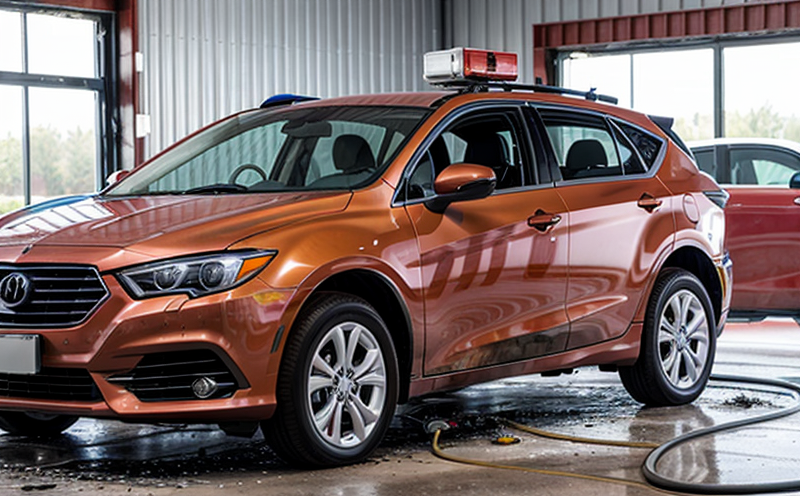ASTM E662 Smoke Density Testing of Vehicle Interior Components
The ASTM E662 test method is a critical standard used to measure the smoke density produced by materials under fire conditions. This test is essential in ensuring that vehicle interior components, including fabrics, plastics, foams, and other materials, do not release excessive amounts of smoke when exposed to heat or flame during a fire event. Smoke density testing helps manufacturers comply with safety regulations and improve occupant safety within automotive interiors.
The ASTM E662 test is based on the principle that certain types of combustion produce dense smoke which can impair visibility and pose serious health risks, particularly in enclosed spaces such as vehicles. By quantifying the amount of light absorbed by this smoke, the ASTM E662 method provides a standardized way to evaluate the fire resistance properties of automotive interior components.
The test involves subjecting samples from various vehicle interior components to controlled combustion conditions within an optical chamber. The rate at which light is attenuated due to smoke formation is measured and reported as smoke density. Compliance with this standard ensures that new materials meet rigorous safety benchmarks established by regulatory bodies like the National Highway Traffic Safety Administration (NHTSA).
Automotive manufacturers rely on ASTM E662 testing throughout their product development lifecycle, from early concept stages through final prototype evaluations before mass production begins. This allows them to identify potential issues early on and make necessary adjustments without compromising overall design aesthetics or functionality.
The process typically starts with selecting representative samples of the materials intended for use in vehicle interiors. These specimens are then prepared according to specified procedures outlined in ASTM E662, ensuring consistency across all tests conducted. Once ready, they undergo rigorous evaluation using specialized equipment designed specifically for this purpose.
Why It Matters
The significance of ASTM E662 smoke density testing cannot be overstated when considering its impact on occupant safety during fires involving vehicles. Excessive levels of smoke can lead to reduced visibility, respiratory distress, and even death if left unchecked. By adhering to the strict guidelines set forth by this standard, automakers contribute significantly towards creating safer environments for passengers.
In addition to enhancing passenger safety, successful completion of ASTM E662 tests also supports broader goals related to sustainability initiatives within the industry. Modern approaches often incorporate eco-friendly materials that must balance both performance and environmental responsibility. Ensuring these alternatives pass rigorous smoke density assessments helps maintain high standards while promoting greener practices.
Moreover, meeting regulatory requirements such as those imposed by NHTSA not only protects consumers but also strengthens brand reputation among stakeholders. Positive outcomes from ASTM E662 evaluations can enhance customer trust and loyalty, thereby fostering long-term success for manufacturers who prioritize compliance with international standards like this one.
Scope and Methodology
| Parameter | Description |
|---|---|
| Test Specimens | The materials to be tested should represent typical usage conditions found in automotive interiors. This includes but is not limited to upholstery fabrics, seating foam, trim elements etc. |
| Combustion Conditions | Specified temperatures and durations ensure consistent results across all samples evaluated under ASTM E662. |
| Optical Chamber | A precisely calibrated chamber where the rate of light absorption by generated smoke is measured. |
The test procedure involves placing a sample into an optical chamber equipped with a source of heat and flame. As combustion occurs, the resulting smoke travels through the chamber towards photodetectors positioned at both ends. The difference in light intensity between these points indicates how much light was absorbed by the smoke particles.
Results are expressed as smoke density units (SDU), which provide an objective measure of the amount of light absorption caused by the generated smoke. Compliance with specified limits ensures that materials meet necessary safety standards regarding their contribution to vehicular fire safety.
Industry Applications
- Material selection for automotive interiors
- R&D phase evaluation of new fabrics and foams
- Quality assurance during production processes
- Regulatory compliance verification
| Application Scenario | Description |
|---|---|
| New Product Development | Engineers can use ASTM E662 data to optimize material choices based on their smoke density performance. This helps in creating safer products while minimizing environmental impact. |
| Pilot Production Runs | Manufacturers ensure that initial production runs meet specified smoke density thresholds before mass production begins. |
| Compliance Audits | The results of ASTM E662 tests serve as evidence during third-party audits conducted by regulatory authorities ensuring continuous adherence to safety regulations. |
By incorporating ASTM E662 into their quality control protocols, companies can ensure that every batch of interior components meets stringent smoke density limits. This not only enhances product safety but also supports overall sustainability goals within the automotive sector.





